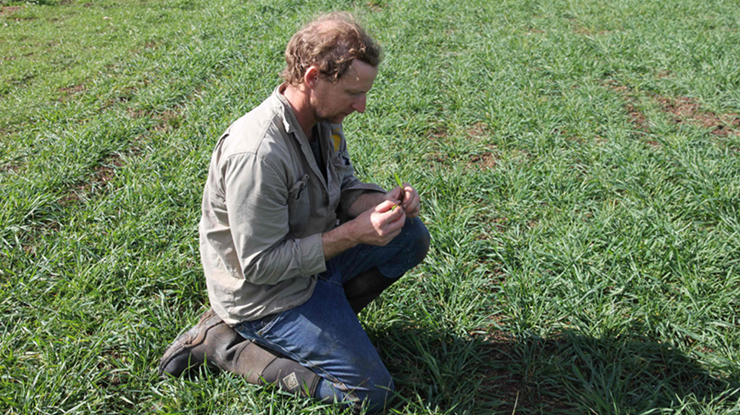 WA producer Ben Webb has seen more cropping success as his sustainable resource management has evolved.
WA producer Ben Webb has seen more cropping success as his sustainable resource management has evolved.
Working the land in WA is no simple feat, and without adaptation, it's only likely to get more difficult. Like many producers, Ben and Emily Webb have been consistently amping up their sustainable resource management, as climate modelling suggests preparation over the coming years will be the secret to success.
Water security, pastures and stocking rates have been the focal points of the recent FutureSheep research project, which modelled how climate change will impact sheep producers in Western Australia.
On their Kojonup property, the Webbs are currently putting their drought-proofing to the test amid a second consecutive poor season, and the preparation is paying off.
"We're missing 200mm of rain this year, but the crops and sheep look good. There just isn't a lot of grass about," Ben said.
Results from FutureSheep suggested livestock and crop systems in areas like Kojunup – a high rainfall zone (HRZ) – will remain profitable with adaptation of current systems.
Conserving moisture
Where water is limited, capturing every drop is crucial. To ensure rainfall was stored either in soil or dams, the Webbs introduced several different measures.
"With continuous cropping of the hilltops, we use a wetting agent at seeding time to suck any moisture into the crops, which does mean less water is getting to the bottom of the hill to fill our dams," Ben said.
Subsurface drainage was installed to counteract the impact on waterlogged areas, and polypipe is used to drain excess water from a wet winter into dams.
Water from freshwater soaks and wet areas have also been used to pump water up into dams.
"It's two birds with one stone. You get water in the dam for the summer, and it dries out another waterlogged area so you can grow a crop there in the winter."
The change has allowed the Webbs to grow crops in places they previously haven't been able to.
"We've started growing winter wheat in the wettest areas, which goes in early to make use of any summer and spring rains. Wheat copes better with being waterlogged than traditional spring crops and helps mitigate the frost risk from those wet areas."
Alongside subsurface drainage, the family is investigating desalination as an option for their property.
"We've had limited success finding good volumes of fresh water, but have found salty water near the house which is feasible for desalination."
Confinement feeding
System changes happen gradually, but in WA, confinement feeding is expected to eventually become the new norm as delayed autumn/winter rain keeps producers feeding sheep.
"We've been confinement feeding since 1996," Ben said.
"We found there was a gap when we wanted to get the sheep off the crops to let them germinate and conserve any moisture."
When winter rain arrives, the Webbs implement confinement feeding, allowing for the pastures to establish and reach target feed-on-offer levels before the sheep are allowed on it.
"It started as just the wethers, but now they all go in there. We might use some frosted wheat we turned into hay, or if we have a weedy crop, we turn it into silage for feeding, as well as using grain," Ben said.
"We're also looking at legume fodder crops, trying different species and whether something will fit for us. If we can make it work, it should be a great break crop and somewhere to finish our lambs without grain."
Getting sheep in shape
Genetics has been a focus for the Webbs to ensure they are breeding sheep which can tolerate climate variability.
The family breed 'easy-care' rams as part of the Merinotech (WA) group, looking for high growth rates and easy finishing.
"A big part of our breeding objective is to raise dual-purpose Merino sheep that we can run at high stocking rates, focusing on fat, muscle and staple strength, as well as easy-care traits including resistance to worms and lower dag, breech wrinkle and breech cover.
"Having sheep with more fat and better condition scores means that they have a better ability to maintain condition in poorer seasons and when there is less grass around in our dry summers."
Reduced stocking rates because of poorer pastures was a projection of the FutureSheep project. The FutureSheep project identified that without adaptation, producers would need to reduce their stocking rates in years to come.
"Ideally there will be more money in sheep in the next few years so we can afford to run a lower stocking rate, but every summer is dry here, so it's good to have sheep which have good fat stores and therefore don't rely so much on the paddock feed or supplementary feeding."
A little does a lot
Having started early, the Webbs are nowhere near finished making improvements to see them through the hard seasons.
While their new systems are helping to get them through the current dry year, the Webbs are still investigating what more can be done, as legume crops, desalination and breeding are still being perfected.
"There is no silver bullet to preparation, but lots of little things help."






